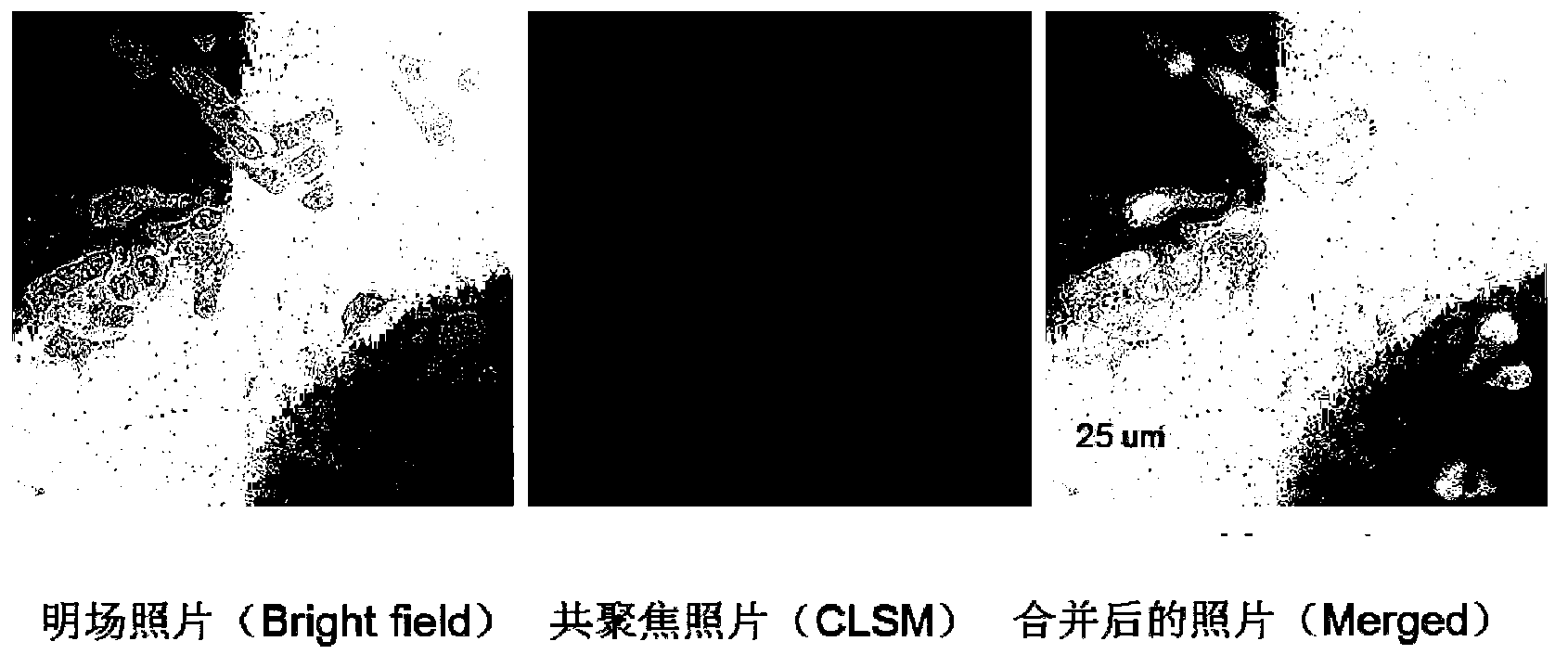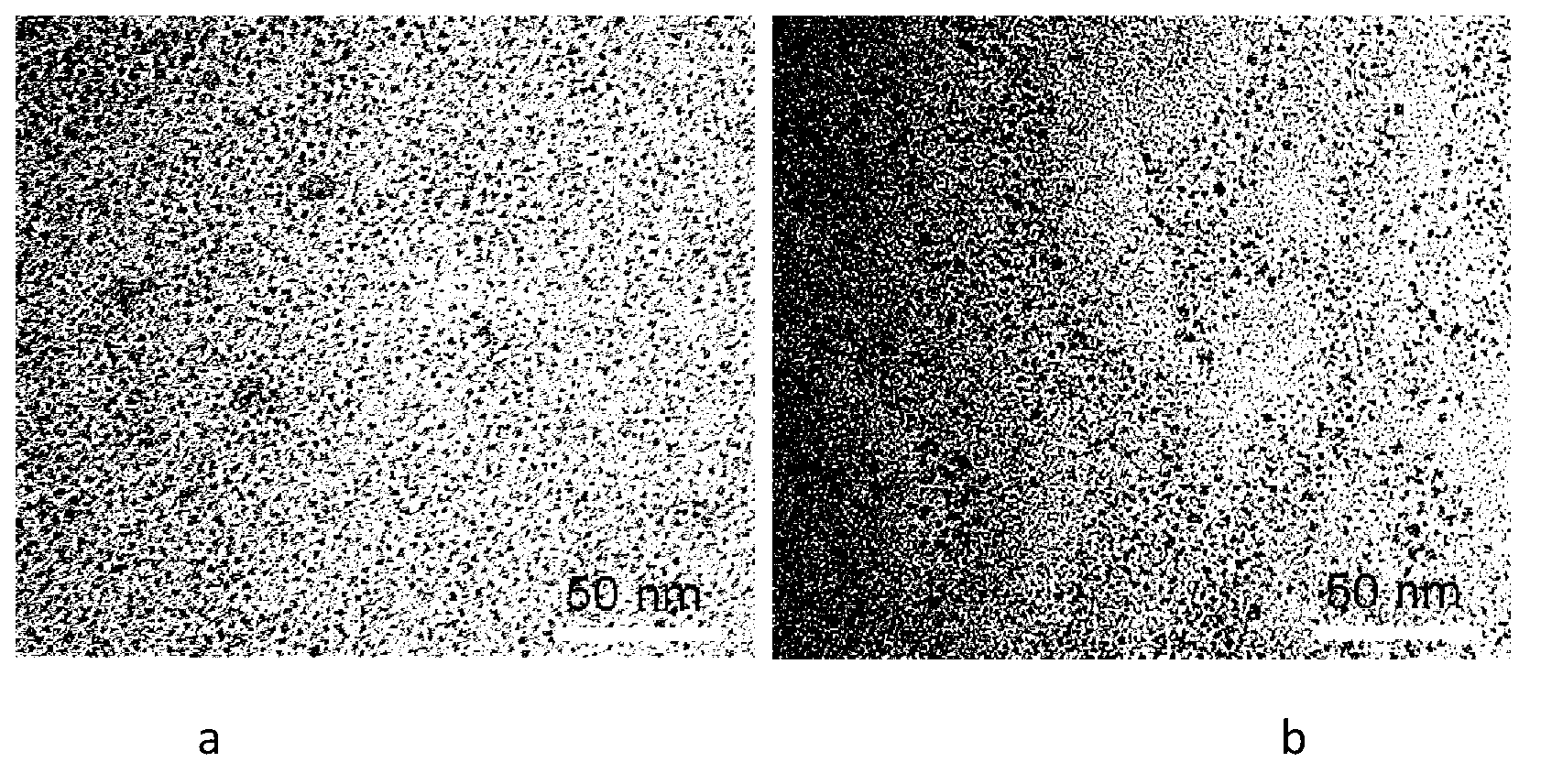Method for synchronously realizing water-phase transfer and nucleus targeting of hydrophobic nanoparticles
A nanoparticle, hydrophobic technology, applied in nanotechnology, nanotechnology, chemical instruments and methods, etc., can solve the problems of inability to achieve water phase conversion, complex process, etc., and achieve the effect of easy operation, simple process and good dispersibility.
- Summary
- Abstract
- Description
- Claims
- Application Information
AI Technical Summary
Problems solved by technology
Method used
Image
Examples
Embodiment 2
[0020] Example 2, preparation of dodecyldimethylbenzyl ammonium chloride modified CdS nanoparticles.
[0021] Get 1ml of chloroform solution (concentration of CdS contained therein is 0.5mg / ml) of CdS nanocrystal (average particle diameter is 3.2nm) coated with oleic acid, under magnetic stirring, slowly add to 40ml dodecyl di methyl benzyl ammonium chloride in aqueous solution (the concentration of dodecyl dimethyl benzyl ammonium chloride in this solution is 0.2M), and then continue magnetic stirring for 24 hours. After 24 hours, use an ultrafiltration centrifuge tube with a molecular weight cut-off of 10 KDa to centrifuge several times (4000 rpm, 10 min / time) to remove excess dodecyldimethylbenzyl ammonium chloride. The final dodecyldimethylbenzylammonium chloride-modified CdS nanoparticles have good dispersion in water, and the average size is about 5.4nm. After co-cultivating CdS nanoparticles modified with dodecyldimethylbenzyl ammonium chloride with human liver cancer ...
Embodiment 3
[0022] Embodiment 3, magnetic Fe modified by dodecyl dimethyl benzyl ammonium chloride 3 o 4 Preparation of nanoparticles.
[0023] Magnetic Fe coated with oleic acid 3 o 4 1ml of chloroform solution of nanoparticles (average particle diameter is 5nm) (the magnetic Fe contained therein 3 o 4 The concentration is 5mg / ml), under mechanical stirring, slowly join in the aqueous solution of 40ml dodecyl dimethyl benzyl ammonium chloride (dodecyl dimethyl benzyl ammonium chloride in this solution concentration of 0.2M), then mechanical stirring was continued for 24 hours. After 24 hours, use an ultrafiltration centrifuge tube with a molecular weight cut-off of 10 KDa to centrifuge several times (4000 rpm, 10 min / time) to remove excess dodecyldimethylbenzyl ammonium chloride. The final dodecyl dimethyl benzyl ammonium chloride modified magnetic Fe 3 o 4The nanoparticles are well dispersed in water with an average size of about 7.6nm. And the dodecyl dimethyl benzyl ammonium ...
Embodiment 7
[0030] Example 7, CuInS modified by cetyltrimethylammonium bromide 2 - Preparation of ZnS nanoparticles
[0031] CuInS coated with oleic acid 2 -ZnS nanoparticles (average particle diameter is 50nm) in chloroform solution 1ml (CuInS contained therein 2 -ZnS concentration is 5mg / ml), under magnetic stirring, slowly join in the aqueous solution of 30ml cetyltrimethylammonium bromide (concentration of cetyltrimethylammonium bromide in this solution is 0.1M), and then continue magnetic stirring for 72 hours. After 72 hours, use an ultrafiltration centrifuge tube with a molecular weight cut-off of 10 KDa to centrifuge several times (4000 rpm, 10 min / time) to remove excess cetyltrimethylammonium bromide. The final cetyltrimethylammonium bromide modified CuInS 2 -ZnS nanoparticles are well dispersed in water with an average size of about 62nm. CuInS modified with cetyltrimethylammonium bromide 2 -ZnS nanoparticles were co-cultured with human umbilical vein endothelial HUVEC cel...
PUM
| Property | Measurement | Unit |
|---|---|---|
| Average size | aaaaa | aaaaa |
| Average size | aaaaa | aaaaa |
| Average size | aaaaa | aaaaa |
Abstract
Description
Claims
Application Information
 Login to View More
Login to View More - R&D
- Intellectual Property
- Life Sciences
- Materials
- Tech Scout
- Unparalleled Data Quality
- Higher Quality Content
- 60% Fewer Hallucinations
Browse by: Latest US Patents, China's latest patents, Technical Efficacy Thesaurus, Application Domain, Technology Topic, Popular Technical Reports.
© 2025 PatSnap. All rights reserved.Legal|Privacy policy|Modern Slavery Act Transparency Statement|Sitemap|About US| Contact US: help@patsnap.com


